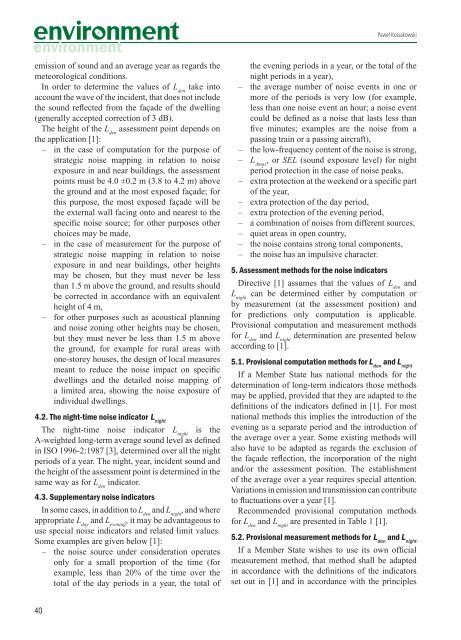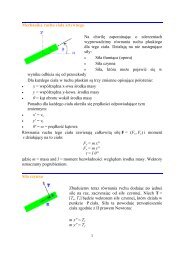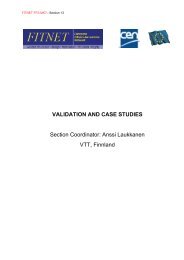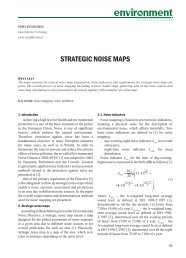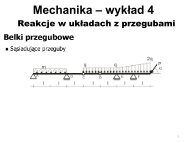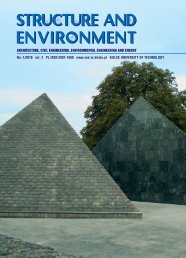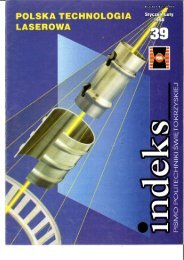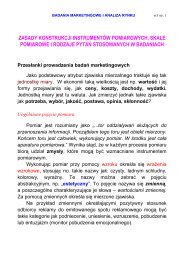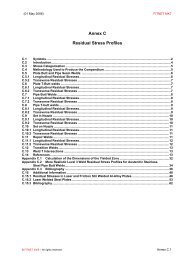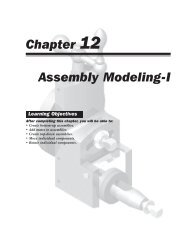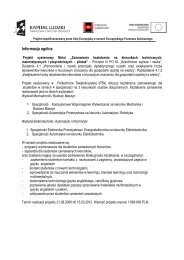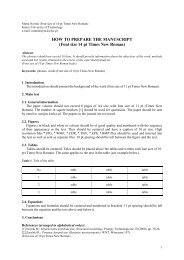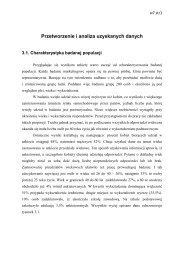STRUCTURE AND ENVIRONMENT STRUCTURE AND ...
STRUCTURE AND ENVIRONMENT STRUCTURE AND ...
STRUCTURE AND ENVIRONMENT STRUCTURE AND ...
Create successful ePaper yourself
Turn your PDF publications into a flip-book with our unique Google optimized e-Paper software.
Paweł Kossakowski<br />
emission of sound and an average year as regards the<br />
meteorological conditions.<br />
In order to determine the values of L den<br />
take into<br />
account the wave of the incident, that does not include<br />
the sound reflected from the façade of the dwelling<br />
(generally accepted correction of 3 dB).<br />
The height of the L den<br />
assessment point depends on<br />
the application [1]:<br />
– in the case of computation for the purpose of<br />
strategic noise mapping in relation to noise<br />
exposure in and near buildings, the assessment<br />
points must be 4.0 ±0.2 m (3.8 to 4.2 m) above<br />
the ground and at the most exposed façade; for<br />
this purpose, the most exposed façade will be<br />
the external wall facing onto and nearest to the<br />
specific noise source; for other purposes other<br />
choices may be made,<br />
– in the case of measurement for the purpose of<br />
strategic noise mapping in relation to noise<br />
exposure in and near buildings, other heights<br />
may be chosen, but they must never be less<br />
than 1.5 m above the ground, and results should<br />
be corrected in accordance with an equivalent<br />
height of 4 m,<br />
– for other purposes such as acoustical planning<br />
and noise zoning other heights may be chosen,<br />
but they must never be less than 1.5 m above<br />
the ground, for example for rural areas with<br />
one-storey houses, the design of local measures<br />
meant to reduce the noise impact on specific<br />
dwellings and the detailed noise mapping of<br />
a limited area, showing the noise exposure of<br />
individual dwellings.<br />
4.2. The night-time noise indicator L night<br />
The night-time noise indicator L night<br />
is the<br />
A-weighted long-term average sound level as defined<br />
in ISO 1996-2:1987 [3], determined over all the night<br />
periods of a year. The night, year, incident sound and<br />
the height of the assessment point is determined in the<br />
same way as for L den<br />
indicator.<br />
4.3. Supplementary noise indicators<br />
In some cases, in addition to L den<br />
and L night<br />
, and where<br />
appropriate L day<br />
and L evening<br />
, it may be advantageous to<br />
use special noise indicators and related limit values.<br />
Some examples are given below [1]:<br />
– the noise source under consideration operates<br />
only for a small proportion of the time (for<br />
example, less than 20% of the time over the<br />
total of the day periods in a year, the total of<br />
the evening periods in a year, or the total of the<br />
night periods in a year),<br />
– the average number of noise events in one or<br />
more of the periods is very low (for example,<br />
less than one noise event an hour; a noise event<br />
could be defined as a noise that lasts less than<br />
five minutes; examples are the noise from a<br />
passing train or a passing aircraft),<br />
– the low-frequency content of the noise is strong,<br />
– L Amax<br />
, or SEL (sound exposure level) for night<br />
period protection in the case of noise peaks,<br />
– extra protection at the weekend or a specific part<br />
of the year,<br />
– extra protection of the day period,<br />
– extra protection of the evening period,<br />
– a combination of noises from different sources,<br />
– quiet areas in open country,<br />
– the noise contains strong tonal components,<br />
– the noise has an impulsive character.<br />
5. Assessment methods for the noise indicators<br />
Directive [1] assumes that the values of L den<br />
and<br />
L night<br />
can be determined either by computation or<br />
by measurement (at the assessment position) and<br />
for predictions only computation is applicable.<br />
Provisional computation and measurement methods<br />
for L den<br />
and L night<br />
determination are presented below<br />
according to [1].<br />
5.1. Provisional computation methods for L den<br />
and L night<br />
If a Member State has national methods for the<br />
determination of long-term indicators those methods<br />
may be applied, provided that they are adapted to the<br />
definitions of the indicators defined in [1]. For most<br />
national methods this implies the introduction of the<br />
evening as a separate period and the introduction of<br />
the average over a year. Some existing methods will<br />
also have to be adapted as regards the exclusion of<br />
the façade reflection, the incorporation of the night<br />
and/or the assessment position. The establishment<br />
of the average over a year requires special attention.<br />
Variations in emission and transmission can contribute<br />
to fluctuations over a year [1].<br />
Recommended provisional computation methods<br />
for L den<br />
and L night<br />
are presented in Table 1 [1].<br />
5.2. Provisional measurement methods for L den<br />
and L night<br />
If a Member State wishes to use its own official<br />
measurement method, that method shall be adapted<br />
in accordance with the definitions of the indicators<br />
set out in [1] and in accordance with the principles<br />
40


